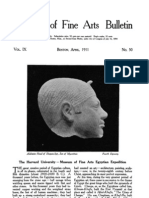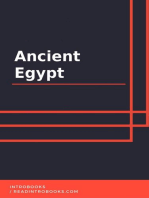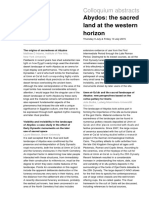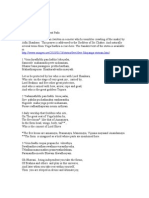History Egypt Intro 6th Sept '12
History Egypt Intro 6th Sept '12
Uploaded by
soniagupta63Copyright:
Available Formats
History Egypt Intro 6th Sept '12
History Egypt Intro 6th Sept '12
Uploaded by
soniagupta63Original Description:
Copyright
Available Formats
Share this document
Did you find this document useful?
Is this content inappropriate?
Copyright:
Available Formats
History Egypt Intro 6th Sept '12
History Egypt Intro 6th Sept '12
Uploaded by
soniagupta63Copyright:
Available Formats
HISTORY OF ARCHITECTURE
1ST SEMESTER OMDAYAL INSTITUTE OF ENGINEERING AND ARCHITECTURE
N.Africa was once a vast fertile area of forests and pasturelands that was populated by humans . But in 6th millenium BCE, warming that affected the globe changed that into a Sahara like desert. People moved to Morrocco , Spain or bank of Nile. Density of the bank of Nile river was unlike any seen at the time and assertions of divinity in local elite assured protection and isolation of power.
One of the oldest Egyptian sites Merimda Beni Salama is a major Predynastic settlement site on the western margin of the Delta, about 60km north-west of Cairo. The site has been found to consist of five levels, showing three phases of occupation dating from 5000 BCE to 4100 BCE, The later or Classic Merimda culture refers to the Level III period of occupation, when the settlement consisted of a large village of mud huts and work spaces in organised groups of buildings which were laid out in streets. The high level of organisation in the villages is indicated by numerous subterranean silos or granaries, lined with basketware and used to store grain, probably associated with individual dwellings.
The suggestion is that by the later phases the population consisted of economically independent family groups in a formalised village life. Most of the burials found among the houses of the settlement contained the bodies of children or adolescents, while it is thought that the adult population must have been buried elsewhere in yet undiscovered cemeteries. The dead were wrapped in matting and accompanied by goods, - clay vessels, shells, idols and wall paintings all point to an aesthetic that would become characteristically Egyptian smooth surfaces ,abstract forms and heroic actions.
Considered one of the most important archaeological sites of ancient Egypt ,100km from Thebes, under the face of an imposing cliff the sacred city of Abydos was the site of many ancient temples, including Umm el-Qa'ab, the royal necropolis, where early pharaohs were entombed. A gorge opens out dramatically through the cliff at the spot and according to some this was regarded as the entrance to the netherworld. These tombs began to be seen as extremely significant burials and in later times it became desirable to be buried in the area, leading to the growth of the town's importance as a cult site. Like no other group of monuments, the graves of the early rulers and kings reflect in their architecture and funerary equipment the particular developmental stage of society and the religious beliefs
Abydos Umm el-Qaab
Hor-Aha's tomb comprises three chambers B10, B15 and B19, shown in inset with over 1.50 m thick brick walls. B14 could be the tomb of Hor-Aha's wife. The chambers are rectangular, directly dug in the desert floor, their walls lined with mud bricks. The tomb of Narmer a had only two adjacent chambers, while the tomb of Hor-Aha comprises three substantially larger yet separated chambers.
The reason for this architecture is that it was difficult at that time to build large ceiling above the chambers. Moreoever timber for these structures often had to be imported from Palestine.
The tomb of Hor Aha was stockplied with provisionslarge cuts of ox meat, freshly killed water birds, loaves of dried bread, figs and jars of beer and wine, each bearing Ahas official seal. There were also more than__________ ancillary graves for servants and animals
The tomb complex of Aha, which was built in three stages, for the first time includes subsidiary burials for servants and takes a qualitative step towards monumental architecture. Thus the new position of the king ruling over a unified Egypt becomes apparent. From Djer (Djet) onwards, the tomb complexes of the kings of the 1st Dynasty, which are set into the desert floor and lined with mud-brick, comprise a large central chamber for the burial of the king and up to 200 subsidiary burials lined in rows containing offerings, the remains of servants and also animals (hunting dogs, lions) .
The chambers were covered with wooden beams and layers of mats and bricks. The kings chamber was superimposed by a sand tumulus, a symbolic primeval mound, which emerged from the primeval waters during the creation of the world. From this building element, which guaranteed the continuation of life, the pyramid developed later on.
In the graves there were also false exits, orientated towards the opening of a wadi (valley or riverbed) in the mountains west of the tombs: the entrance to the netherworld, which the resurrected king was supposed to enter
Merneith is believed to have become ruler upon the death of her husband, Djet. The title she held, however, is debated. It is possible that her son Den was too young to rule when Djet died, so she may have ruled as regent until Den was old enough to be the king in his own right.
The strongest evidence that Merneith was a ruler of Egypt is her tomb. This tomb in Abydos (Tomb Y) is unique among the otherwise exclusively male tombs. Merneith was buried close to Djet and Den.
Her tomb is of the same scale as the tombs of the kings of that period. Inside her tomb archaeologists discovered a solar boat, that would allow her to travel with the sun deity in the afterlife. The framing around the tomb is open on the SW side presumably that the spirit can escape through the gorge through the cliff. In Dens tomb this was more explicit a special chamber next to the tomb with separate stair leading to the west. Merneiths name appears on a seal found in the tomb of her son, Den. The seal includes Merneith on a list of the first dynasty kings. Merneith's name was the only name of a woman included on the list. However, Merneith's name is accompanied by the title "King's Mother".
An important innovation during Dens reign was the introduction of numbering using hieroglyphs. Den is said to have brought prosperity to his realm and numerous innovations are attributed to his reign. He was the first to use the title King of Lower- and Upper Egypt, and the first depicted as wearing the double crown (red and white).
Tomb T is among the largest and most finely-built of the tombs in this area, and is the first to feature a staircase and floor of his tomb at Umm el-Qa'ab near Abydos is made of red and black granite, the first time in Egypt this hard stone was used as a building material.
In the original layout for the tomb, a wooden door was located about half-way up the staircase, and a portcullis placed in front of the burial chamber, designed to keep out tomb robbers
Semerkhet's burial site was excavated and is known as "Tomb U". While excavating, no stairways like at the necropolis of Den .He found a ramp, four metres wide and leading straight into the main chamber. The burial chamber measures 29.2 20.8 metres and is of simple construction.
Qa'a had a fairly large tomb in Abydos which measures 30 X 23 meters. A long reign is supported by the large size of this ruler's burial site at Abydos. A seal impression was found of Qa'a (Tomb Q) The discovery near the entrance of the tomb of the seal impression bearing Hotepsekhemwy's name, has been interpreted as evidence that Qa'a was buried, and therefore succeeded, by Hotepsekhemwy, the founder of the second dynasty of Egypt
The beautiful tomb stela of Qa'a is now on display at the University of Pennsylvania Museum of Archaeology and Anthropology. The tradition of burying the family and court of the king when he died was abandoned at the time of king Qaa, one of the last rulers of the 1st dynasty.
In this early stage of Egyptian culture, there was no temple architecture as in China where religion unified society. Architecture was meant as interface between life and death for members of the elite. It has much less social proliferation but wonderfully Dramatic. Death for the Chinese was handing down of family memoirs articulated spatially within house shrines and fragile wooden temples. In Egypt death was majestic making the way for a simulated house with all arrangements for a comfortable afterlife. How the spirit moved about was to determine the flow of history while entombing the house
Archaeological evidence suggests that unification of Egypt was a slow process that took several centuries. This unification as Old Kingdom combined with rapid development of hieroglyphic script and powerful bureaucracy was the final transformation of this complex and vertically structured society of several million. This organisation of efficient work force that little contact with ruling elite and its ..unlike Mesopotamia and China. Thus large numbers of labourers, slaves and then cooks, technicians, bureaucrats were all employed solely for royal projects.
No shortage of building material red granite of Aswan, white marble of Gebel Rokham and black basalt of Faiyum and various types of sandstone from Nubia. By 3rd dynasty of Old Kingdom political stability of Egypt was secure with Zoser creating building projects against which later kings would measure their accomplishments. The Mortuary Complex of Zoser just north of Saqqara was enclosed by 277m x 544m x 10.5m wall laid out in precise orientation to 4 cardinal points.
The Saqqara royal tombs were cut from the bedrock and incorporated a new design, unlike the earlier tombs at Abydos that were basically pits lined with mudbricks. The practice of building subsidiary graves for family and servants surrounding the royal tomb was discontinued. Hetepsekhemwys immense tomb, very close to the Pyramid of Unas with extensive galleries partly underlying the pyramid, was identified by numerous seal impressions bearing the Kings Horus names and those of his successor Nebre, but his tomb was otherwise empty.
You might also like
- Goa1556 Catalogue :: Books From GoaDocument54 pagesGoa1556 Catalogue :: Books From GoaFrederick Noronha33% (3)
- Williams CHURCH & STATE PerusalDocument163 pagesWilliams CHURCH & STATE PerusalLaura D'AmoreNo ratings yet
- The Oxford Encyclopedia of Ancient Egypt Vol.1Document583 pagesThe Oxford Encyclopedia of Ancient Egypt Vol.1Арнауд Никодимов95% (19)
- David O'Connor....... Abydos, Egypt's First Pharaohs & The Cult of Osiris (By House of Books)Document219 pagesDavid O'Connor....... Abydos, Egypt's First Pharaohs & The Cult of Osiris (By House of Books)Laurie Romano91% (11)
- Nile Valley CivilisationDocument12 pagesNile Valley CivilisationHareesh GummagattaNo ratings yet
- Dua of Imam Husain For Arafah DayDocument100 pagesDua of Imam Husain For Arafah DayTurkish BoyNo ratings yet
- Module 1Document88 pagesModule 1karthikaNo ratings yet
- Kemet: The History of Ancient EgyptFrom EverandKemet: The History of Ancient EgyptRating: 3.5 out of 5 stars3.5/5 (4)
- The Valley of The Kings-2019-Part OneDocument48 pagesThe Valley of The Kings-2019-Part OneAbd El-Rahman HassanNo ratings yet
- FILE023Document48 pagesFILE023Egyptian TreasureNo ratings yet
- Reaction Paper (Egyptian Architecture)Document3 pagesReaction Paper (Egyptian Architecture)xandra ylaineNo ratings yet
- Egyptian Architecture2014Document14 pagesEgyptian Architecture2014Naveen KumarNo ratings yet
- INDIA AND THE WORLD. History TimelineDocument62 pagesINDIA AND THE WORLD. History Timelineworld civilization100% (2)
- Museum Fine Arts: BulletinDocument8 pagesMuseum Fine Arts: BulletinGhada Sayed MohamedNo ratings yet
- Valley of The KingsDocument31 pagesValley of The KingsIuliana-Alexandra Subtirica100% (1)
- Djoser and The Pyramid AgeDocument32 pagesDjoser and The Pyramid AgeVanditaNo ratings yet
- 04.Egyptian civilization.pdfDocument40 pages04.Egyptian civilization.pdf70135276No ratings yet
- Egyptian Civilization: The Nile Dynastic Egypt Religion WritingDocument56 pagesEgyptian Civilization: The Nile Dynastic Egypt Religion WritingLerma Luluquisen MejiaNo ratings yet
- Egypt S Secrets of Ancient WordlDocument2 pagesEgypt S Secrets of Ancient WordlnaokiyokoNo ratings yet
- Bydos: The Archaeology of SouthDocument5 pagesBydos: The Archaeology of SouthKıvanç TatlıtuğNo ratings yet
- History of ArchitectureDocument90 pagesHistory of ArchitectureReina Carrie M DimlaNo ratings yet
- Queens' Valley-Nobles and Deir El MadinaDocument26 pagesQueens' Valley-Nobles and Deir El MadinaAbd El-Rahman HassanNo ratings yet
- Ancient EgyptDocument37 pagesAncient EgyptNeric Ico MagleoNo ratings yet
- Quiz 2 NotesDocument22 pagesQuiz 2 NotesKyleNo ratings yet
- Lecture 3 - EgyptianDocument44 pagesLecture 3 - EgyptianBisrateab FekaduNo ratings yet
- Secrets of The PyramidsDocument8 pagesSecrets of The Pyramidsivo_doki22No ratings yet
- 2 Egyptian Arch're - EDITEDDocument120 pages2 Egyptian Arch're - EDITEDrazelrufino8No ratings yet
- WL IiDocument7 pagesWL Iijelostamariac15No ratings yet
- Report 130204154825 QQQ PDFDocument33 pagesReport 130204154825 QQQ PDFPragya ChattreeNo ratings yet
- Egyptian Civilization NewDocument56 pagesEgyptian Civilization Newmaaz basirNo ratings yet
- The Seven Wonders of The Ancient WorldDocument26 pagesThe Seven Wonders of The Ancient Worlddejeh ocba100% (1)
- British Museum: Ancient Egypt IDocument6 pagesBritish Museum: Ancient Egypt IgabisaenaNo ratings yet
- Articule - Tell El-Farkha - Cialowicz Krzysztof MDocument14 pagesArticule - Tell El-Farkha - Cialowicz Krzysztof MGerardo P. TaberNo ratings yet
- 02 History of Architecture-I Part A Western Lecture 2-Egyptian-MesopotamianDocument151 pages02 History of Architecture-I Part A Western Lecture 2-Egyptian-MesopotamianPradip PokhrelNo ratings yet
- Egyptian Arch'ReDocument140 pagesEgyptian Arch'ReMichael Jay Tinoko ManaloNo ratings yet
- Arch 217Document34 pagesArch 217Champion AKALINo ratings yet
- Egyptian Architecture 1 LastDocument5 pagesEgyptian Architecture 1 LastzekimamaruNo ratings yet
- Lecture 2Document68 pagesLecture 2chanchal modiNo ratings yet
- 1 Sudanese US.Document6 pages1 Sudanese US.AlexShearNo ratings yet
- Tombs of Kings in The Middle KingdomDocument5 pagesTombs of Kings in The Middle KingdomMizo GamingNo ratings yet
- 02 Johnson DrukDocument20 pages02 Johnson DrukAna María Fontela SalinasNo ratings yet
- TCI - History Alive Ancient Egypt LessonDocument24 pagesTCI - History Alive Ancient Egypt Lessonsamupul19No ratings yet
- 03 Egyptian Architecture NDDU FinalDocument114 pages03 Egyptian Architecture NDDU FinalBruce Mon100% (1)
- Principles of Tourism2-2Document35 pagesPrinciples of Tourism2-2Paul Jasper BaronaNo ratings yet
- 7 Wonders of The WorldDocument17 pages7 Wonders of The WorldMirela MarinescuNo ratings yet
- Egyptian Art and ArchitectureDocument3 pagesEgyptian Art and ArchitectureRmigNo ratings yet
- Ancient EgyptDocument3 pagesAncient EgyptVarshit NunnaNo ratings yet
- Seven World WondersDocument31 pagesSeven World WondersBookyNo ratings yet
- Ancient EgyptDocument76 pagesAncient EgyptnohleNo ratings yet
- Inbound 2475745872059303227Document26 pagesInbound 2475745872059303227Rohjan Mas ReyesNo ratings yet
- Egyptian Art and ArchitectureDocument36 pagesEgyptian Art and ArchitectureDarwin CandelonNo ratings yet
- Presentation 1Document11 pagesPresentation 1banafshaNo ratings yet
- American Association For The Advancement of ScienceDocument18 pagesAmerican Association For The Advancement of ScienceAlsayedBadranNo ratings yet
- Abydos: The Sacred Land at The Western Horizon: Colloquium AbstractsDocument5 pagesAbydos: The Sacred Land at The Western Horizon: Colloquium AbstractsAmunious KamelNo ratings yet
- Art in Early CivilizationDocument25 pagesArt in Early CivilizationLeana NopiaNo ratings yet
- Bmfa21 1923 11to27Document17 pagesBmfa21 1923 11to27roger_pearse100% (1)
- Beneath the Sands of Egypt: Adventures of an Unconventional ArchaeologistFrom EverandBeneath the Sands of Egypt: Adventures of an Unconventional ArchaeologistRating: 3.5 out of 5 stars3.5/5 (13)
- The Tomb of OzymandiasDocument3 pagesThe Tomb of OzymandiasJenny BenalcázarNo ratings yet
- So, Blessed Indeed Is The Man That Trusteth in Himself - For Man's Faith in GodDocument2 pagesSo, Blessed Indeed Is The Man That Trusteth in Himself - For Man's Faith in GodjackypourNo ratings yet
- Welcome To This Presentation Of: DeepavaliDocument28 pagesWelcome To This Presentation Of: DeepavaliSamparkvibhag Andhrapradesh RssNo ratings yet
- Railways Practice Set 1 2016 PDFDocument6 pagesRailways Practice Set 1 2016 PDFbadhraNo ratings yet
- When Forgiveness Seems ImpossibleDocument33 pagesWhen Forgiveness Seems ImpossibleGrady ClubbNo ratings yet
- Letter To Parents On PEAC and Other ScheduleDocument1 pageLetter To Parents On PEAC and Other ScheduleGilson BautistaNo ratings yet
- 15 Conclusion PDFDocument6 pages15 Conclusion PDFKrishnaNo ratings yet
- SeraphDocument5 pagesSeraphHeidi Cayobit0% (1)
- Re-Gifting To The King: How Did The Wisemen Know To Seek Jesus?Document6 pagesRe-Gifting To The King: How Did The Wisemen Know To Seek Jesus?James BayucanNo ratings yet
- History and Background of KoreaDocument7 pagesHistory and Background of KoreaLorry Angela SalvatierraNo ratings yet
- CLE-7-3e DLSR Worksheets U1-C1 PDFDocument22 pagesCLE-7-3e DLSR Worksheets U1-C1 PDFJoemar YubokmeeNo ratings yet
- Interview With Father LarcherDocument4 pagesInterview With Father LarcherShahab Azmoudeh100% (1)
- 2021 08 Cultures of ASEAN Countries CHAPTER 3Document25 pages2021 08 Cultures of ASEAN Countries CHAPTER 3Trứng Là EiNo ratings yet
- Devi Bhujanga StotramDocument8 pagesDevi Bhujanga StotramPuducode Rama Iyer RamachanderNo ratings yet
- On The History and Hermeneutics of ComicDocument27 pagesOn The History and Hermeneutics of ComicdevindinayanatharadnNo ratings yet
- Romanasque ArtDocument1 pageRomanasque ArtHridhya mpNo ratings yet
- TopicsDocument6 pagesTopicsJhun DichosaNo ratings yet
- Quiz MythologyDocument4 pagesQuiz MythologyAprilyn Joy Arroyo QuezadaNo ratings yet
- Module of English 2 For PAI-dikonversiDocument19 pagesModule of English 2 For PAI-dikonversinormanofianto poltekkesNo ratings yet
- A Short Biography of Swami Dayananda SaraswatiDocument12 pagesA Short Biography of Swami Dayananda SaraswatiBhavesh MerjaNo ratings yet
- Yoga QuizDocument4 pagesYoga QuizRajendra ShakyawalNo ratings yet
- Tracts - Little Sin Great EffectDocument2 pagesTracts - Little Sin Great EffectUbong JesusNo ratings yet
- Finality of ProphethoodDocument10 pagesFinality of Prophethoodmsofian msofian67% (3)
- Writing PromptsDocument41 pagesWriting Prompts0787095494100% (8)
- Michael Marder Arhe7Document11 pagesMichael Marder Arhe7Rajlakshmi GhoshNo ratings yet
- Chennai Ramadan Calendar 2024 UrdupointDocument2 pagesChennai Ramadan Calendar 2024 UrdupointAbdul Samad ShaikNo ratings yet
- Srno Application Name Father Name Scheme Name Course Name Application Renewed or NotDocument5 pagesSrno Application Name Father Name Scheme Name Course Name Application Renewed or NotZakyNo ratings yet
- Muslim Contributions BookDocument174 pagesMuslim Contributions Bookamanraza786ali123No ratings yet

























































































